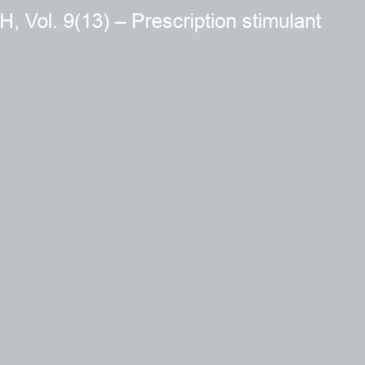With ever-increasing rates of high school students being prescribed stimulants for attention-deficit/hyperactivity disorder (ADHD; Garfield et al., 2012), a substantial percentage of high school students are exposed to medical stimulants, both legally and illicitly. However, there have been few systematic, large-scale studies of prescription stimulant use among high school students. This week’s STASH reviews a national survey of high school students’ prescription stimulant use and its relation to other drug and alcohol use behavior (McCabe & West, 2013).
Methods
- The data for this study were collected as part of the larger Monitoring the Future (MTF) study (http://www.monitoringthefuture.org/). This study used data from the 2010 and 2011 cohorts.
- MTF is an annual, nation-wide study that surveys high school students about a variety of behaviors, beliefs, and attitudes.
- The sample size for this study was 4,572 participants.
- The MTF substance use questions of interest asked participants whether they had a prescription for medical stimulants; how many times they used prescription stimulants, both with and without a prescription; and how many times they binge drank, smoked, used marijuana or other illicit drugs, and used other prescription drugs in their lifetime.
- Participants were separated into five mutually-exclusive groups based on their prescription stimulant use:
- No lifetime stimulant use
- Medical-use only
- Medical use before non-medical use1
- Non-medical use before medical use, and
- Non-medical use only
- Researchers conducted chi-square tests and linear regression models to determine whether prescription stimulant use related to other drug and alcohol use behaviors.
Results
- About 15.5% of all high school seniors reported any lifetime prescription stimulant use. More specifically,
- 256 (5.6%) used stimulants only as medically indicated.
- 100 (2.2%) used stimulants for medical purposes before non-medical use.
- 78 (1.7%) used stimulants non-medically before medical use.
- 270 (5.9%) used stimulants only non-medically.
- All groups, except for those who only used medically, were significantly more likely to engage in all of the other assessed drug or alcohol use behaviors than those who had never used prescription stimulants. The medical-use only group showed elevated risk of non-marijuana illicit substance use, but not for any other substance abuse category. Please see Table 1 for the adjusted odds ratios for each group.
|
Group |
Any smoking in past 30 days |
Any binge drinking in past 2 weeks |
Any marijuana use in lifetime |
Non-marijuana illicit drug use in lifetime |
Any other non-medical prescription drug use in lifetime |
|
Never used stimulants |
– |
– |
– |
– |
– |
|
Medical use only |
1.3 [0.8, 2.1] |
1.1 [0.7, 1.8] |
1.7 [0.9, 3.0] |
2.1* [1.2, 3.8] |
1.0 [0.5, 1.8] |
|
Medical use before non-medical use |
6.3** [3.5, 11.3] |
3.6** [2.0, 6.5] |
5.4** [2.7, 10.6] |
8.6** [4.5, 16.3] |
12.0** [6.5, 22.3] |
|
Non-medical use before medical use |
4.2** [2.2, 8.3] |
6.6** [3.2, 13.4] |
13.3** [6.8, 25.9] |
17.7** [8.7, 35.8] |
25.2** [11.7, 54.1] |
|
Non-medical use only |
6.5** [4.5, 9.6] |
4.5** [3.1, 6.6] |
6.6** [4.4, 9.8] |
17.6** [11.7, 26.7] |
11.8** [7.9, 17.5] |
Figure. Relationships between prescription stimulant use and other drug and alcohol use behaviors. Note: Data are presented as adjusted odds ratios followed by the 95% confidence interval in square brackets. Researchers corrected for race, year, geographical region, and metropolitan statistical area. * p < .05, ** p < .001
Limitations
- The MTF data, and therefore the data used for this study are entirely self-report. Self-report are often less reliable than other types of data (such as direct observation) because people can provide untruthful answers. This is particularly true for subjects like substance use, as participants might be afraid of the consequences of their answers.
- This study is limited to high school seniors, and therefore might have limited generalizability.
Conclusions
Nearly one in six high school seniors surveyed reported using stimulants in their lifetime. Of these people, those who used prescription stimulants non-medically were significantly more likely to engage in all surveyed alcohol and drug use behaviors than non-users. These effects were for the most part observed only among those who used prescription stimulants non-medically, although even those who used stimulants medically were more likely than those with no use to engage in non-marijuana illicit drug use. This might be because those who use stimulants non-medically might have risk factors that encourage them to use other illicit substances as well. These students might also be more adept at locating and purchasing controlled substances. These data show that as prescription stimulants become more common in high schools, parents, and physicians might need to pay special attention to potential substance use, especially for those students using stimulants non-medically.
-Daniel Tao
What do you think? Please use the comment link below to provide feedback on this article.
References
Garfield, C.F., Dorsey, E.R. Zhu, S., Huskamp, H.A., Conti, R., Dusetzina, S.B., Higashi, A., Perrin, J.M., Kornfield, R., Alexander, C. (2012). Trends in attention deficit hyperactivity disorder ambulatory diagnosis and medical treatment in the United States, 2000-2010. Academic Pediatrics, 12(2), 110-116.
McCabe, S.E., West, B.T. (2013). Medical and non-medical use of prescription stimulants: Results from a national multicohort study. Journal of the American Academy of Child and Adolescent Psychiatry, 52(12), 1272-1280.
________________
[1] Medical use was classified as any prescription stimulant use “because a doctor told you to”. Non-medical use was classified as any use “on your own – that is, without a doctor telling you to”.




